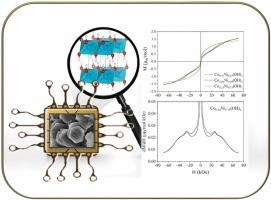Ferromagnetic and antiferromagnetic interactions in two-dimensional layered β-Co1-xNix(OH)2 (x = 0.25; 0.50; 0.75) double hydroxides
IF 6.3
2区 材料科学
Q2 CHEMISTRY, PHYSICAL
引用次数: 0
Abstract
In this work, we present a complete crystallographic, morphological and structural characterization joined with a focused feature and discussion of the magnetic properties in two-dimensional layered β-Co1-xNix(OH)2 (x = 0.25; 0.50; 0.75) sheets. These polycrystalline samples were prepared via colloidal method at 80 °C. Powder X-ray diffraction (PXRD) patterns at room temperature, showed layered structures belonging to Pm1 space group. X-ray photoelectron spectroscopy (XPS) determined the M2+ oxidation state in both cobalt and nickel elements in the surface hydroxides. Scanning electron microscopy (SEM) and transmission electron microscopy (TEM) micrographs revealed clear hexagonal structures for Co0.75Ni0.25(OH)2 and Co0.50Ni0.50(OH)2. However, agglomerated particles were observed in the sample with the highest Ni content. The magnetization of all studied compositions was investigated over a temperature range of 5-300 K and at different applied magnetic fields. At low temperatures (10-30 K) the magnetic ordering temperature (Tc) was identified. This latter follows a linear behavior, increasing with the Ni content (x) in the hydroxides. From the magnetic susceptibility at high temperatures (T>TC), the data can be well described with a Curie-Weiss law, obtaining the Curie constant and Curie-Weiss temperature. The effective magnetic moment obtained is in a good agreement with the spin only for the Ni2+ (3d8) and for a Co2+ (3d7) with some orbital coupling. This comprehensive characterization is crucial for understanding these 2D materials and highlights their potential for advanced spintronics and magnetic data storage applications.

二维层状β-Co1-xNix(OH)2 (x = 0.25; 0.50; 0.75)双氢氧化物的铁磁和反铁磁相互作用
在这项工作中,我们提出了完整的晶体学,形态学和结构表征,并结合了二维层状β-Co1-xNix(OH)2 (x = 0.25; 0.50; 0.75)片的磁性能的重点特征和讨论。这些多晶样品采用胶体法制备,温度为80℃。粉末在室温下的x射线衍射(PXRD)图显示为层状结构,属于P3¯3¯m1空间群。x射线光电子能谱(XPS)测定了表面氢氧化物中钴和镍元素的M2+氧化态。扫描电镜(SEM)和透射电镜(TEM)显示,Co0.75Ni0.25(OH)2和Co0.50Ni0.50(OH)2具有清晰的六边形结构。而在镍含量最高的样品中观察到团聚颗粒。在5-300 K的温度范围和不同的外加磁场下,研究了所有研究成分的磁化强度。在低温(10 ~ 30 K)下,确定了磁有序温度(Tc)。后者遵循线性行为,随着氢氧化物中Ni含量(x)的增加而增加。从高温磁化率(T>;TC)可以很好地用居里-魏斯定律描述数据,得到居里常数和居里-魏斯温度。所得的有效磁矩仅对Ni2+ (3d8)和具有一定轨道耦合的Co2+ (3d7)具有较好的自旋一致性。这种全面的表征对于理解这些二维材料至关重要,并突出了它们在先进自旋电子学和磁数据存储应用方面的潜力。
本文章由计算机程序翻译,如有差异,请以英文原文为准。
求助全文
约1分钟内获得全文
求助全文
来源期刊

Journal of Alloys and Compounds
工程技术-材料科学:综合
CiteScore
11.10
自引率
14.50%
发文量
5146
审稿时长
67 days
期刊介绍:
The Journal of Alloys and Compounds is intended to serve as an international medium for the publication of work on solid materials comprising compounds as well as alloys. Its great strength lies in the diversity of discipline which it encompasses, drawing together results from materials science, solid-state chemistry and physics.
 求助内容:
求助内容: 应助结果提醒方式:
应助结果提醒方式:


